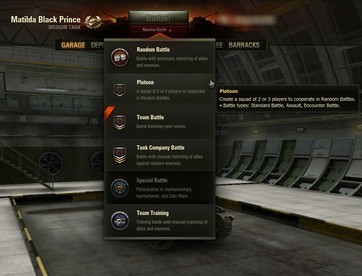When you play low tier battles, from tier I to tier V, the other players tend to have low skilled crews. Some players you will meet are likely to have played only a few battles in their tanks, and they might use crews at 90% base skill, or they have just started grinding their first skill.
But when you enter higher tier battles, tier VIII and above, you will meet players who use crews with three or more skills on their crew. If you use a low skilled crew, you will struggle a lot. Therefore you should take crew training seriously.
To train crew faster, it is advisable to use premium tanks, since they train crews faster than ordinary tanks.
There are two different strategies to training crews and prepare them for higher tier battles.
Strategy A: Boosting single crew members
If you are training a new crew for a specific type of tanks, and you already have one good crew for the same type of tank, you may use a “single crew member boost strategy”.
For example: My Cromwell (British medium) crew are all on their fourth skill, about 35-40%. I am also playing the tier VIII British medium Centurion I. My crew on that tank is not as good as the Cromwell crew, since they are at their third skill, about 25-30%. What I do, is to use the Cromwell Berlin for boosting the Centurion crew, one by one. The Cromwell Berlin has a crew of five. When playing it, I choose four crew members from the ordinary Cromwell, and one crew member from the Centurion I. Then playing the daily double will boost all the crew, but the crew member with the “lowest” skill will get a double boost. So when I play the Cromwell Berlin once a day (or whatever), the one crew member from the Centurion I will get xp very fast.
The reason for choosing strategy A is obvious: You can grind a single crew members xp and still have a great crew in the tank. The tank will perform very good.
There are some downsides, however:
- If – in my example – the Cromwell crew has Brothers in arms and the Centurion crew member hasn’t, I will not get a benefit from that perk, since all crew members must have it. Brothers in arms is only effective when all crew members has reached 100%.
- The skill profile might me suboptimal. Again I will use the Cromwell Berlin example: On a tier VI medium like the Cromwell, camouflage is a bit better than repairs, because of the low hit points on the Cromwell. On a tier VIII, repairs is a bit better. Grinding a tier VIII crew in a tier VI might not be ideal, then. (But I still believe it is a viable strategy.)
Strategy B: Boosting multiple crew members
This is the opposite to to strategy A. Let me use an example from my recent battles: I have both the Ferdinand and the Jagdpanther II. Since I have multiple premium German tank destroyers, I decided to boost both of the crews on the Ferdinand and the Jagdpanther II. Therefore I played a lot of battles, constantly choosing the worst crew members from each tank in one of the premium tanks. I took me quite a while, but now both of these tier VIII tanks have crews on their fourth skill. I chose this way of doing it, since there are a total of 11 crew members on these tanks, and since I didn’t have a better crew in any other German tank destroyer.
The downside is that this takes a lot of time. I do not know how many battles I have played only to boost the crews on these two tanks, but it must be more than 100.
But from now on, I will choose strategy A to boost my Rheinmetall Borsig crew, one by one. I will soon have unlocked the tier IX tank German tank destroyers, and I will be able to put very decent crews in them.


